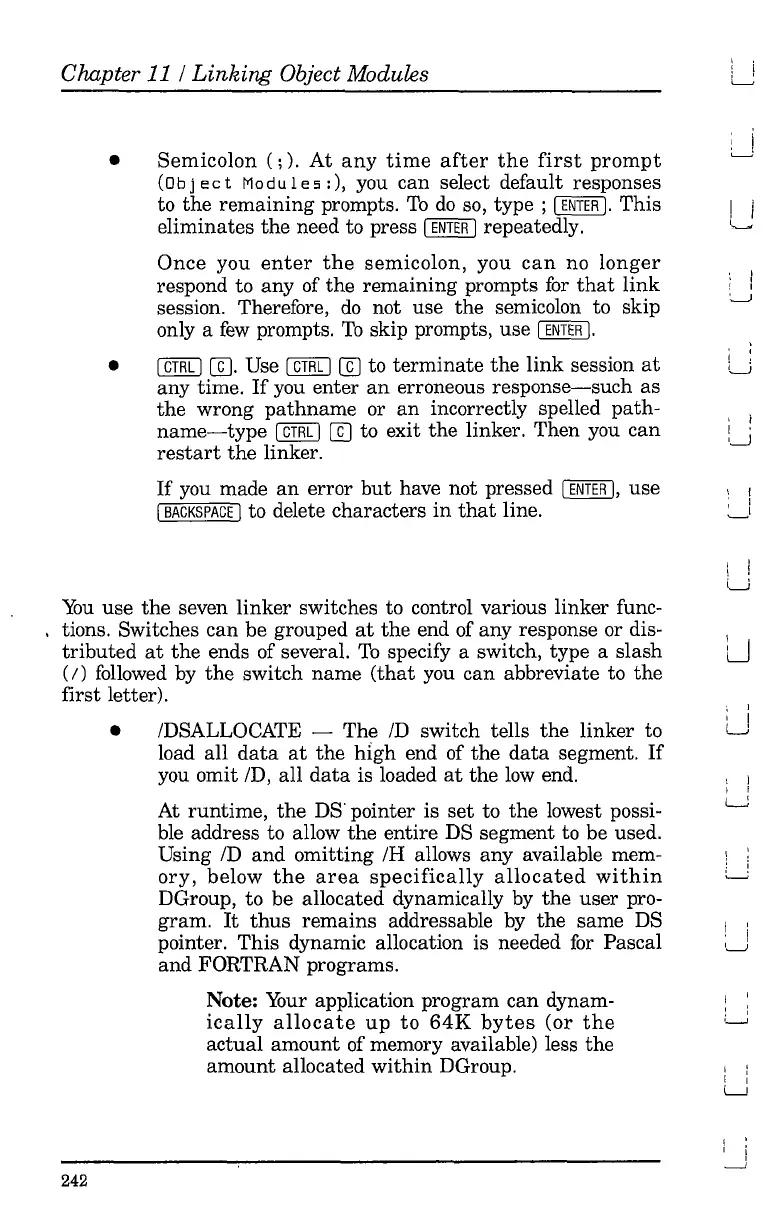Chapter 11 /
Linking
Object Modules
, I
! :
L..J
, I
, I
, I
~
, i
I '
,--'
I i
, I
c........
Semicolon
(;).
At
any
time
after
the
first
prompt
(0
b j e
et
Mod
u 1
e:;
:
),
you can select default responses
to
the
remaining
prompts.
To
do
so,
type;
I
ENTER
I.
This
eliminates
the
need to press I
ENTER
1 repeatedly.
Once
you
enter
the
semicolon, you
can
no
longer
respond to any of the remaining prompts
for
that
link
session. Therefore,
do
not use the semicolon to skip
only a
few
prompts.
To
skip prompts, use I
ENTER
I.
I
CTRL
1
[g.
Use I
CTRL
I
[g
to
terminate
the
link
session
at
any time.
If
you enter
an
erroneous
response-such
as
the
wrong
pathname
or
an
incorrectly spelled path-
name-type
I
CTRL
I
[g
to exit
the
linker. Then you
can
restart
the
linker.
If
you made
an
error
but
have not pressed I
ENTER
I,
use \ I
I
BACKSPACE
Ito delete characters
in
that
line. :.-i
•
•
\ I
u
You
use
the
seven linker switches to control various linker func-
. tions. Switches
can
be grouped
at
the
end of any response or dis-
'
u
,
tributed
at
the
ends of several.
To
specify a switch, type a slash
(;)
followed by
the
switch name
(that
you can abbreviate to
the
first letter).
•
IDSALLOCATE - The ID switch tells
the
linker to
load
all
data
at
the
high
end of
the
data
segment.
If
you omit ID, all
data
is loaded
at
the
low
end.
At runtime,
the
DS' pointer is
set
to
the
lowest possi-
ble address to allow
the
entire DS segment to be used.
Using
ID
and
omitting
IH
allows any available mem-
ory,
below
the
area
specifically
allocated
within
DGroup, to be allocated dynamically by
the
user pro-
gram.
It
thus
remains
addressable
by
the
same DS
pointer.
This
dynamic allocation is needed
for
Pascal
and
FORTRAN programs.
Note:
Your
application program
can
dynam-
ically
allocate
up
to
64K
bytes
(or
the
actual
amount of memory available) less the
amount allocated
within
DGroup.
: I
~
I
L.....J
: I
I I
L.J
I '
LJ
I I
, '
, ,
'--'
I :
I I
L..J
, .
i i
I
------J
242
